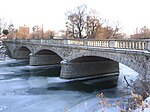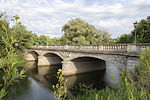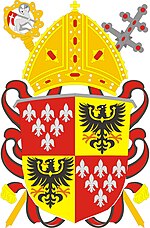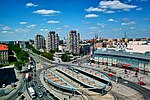Grunwald Bridge
Art Nouveau architecture in WrocławArt Nouveau bridgesBridges completed in 1910Bridges in WrocławEuropean bridge (structure) stubs ... and 4 more
Poland transport stubsPolish building and structure stubsRoad bridges in PolandSuspension bridges in Poland

Grunwald Bridge (Polish: Most Grunwaldzki) is a suspension bridge over the river Oder in Wrocław, Poland, built between 1908 and 1910. Initially the bridge was called the Imperial Bridge (Kaiserbrücke), then the Bridge of Freedom (Freiheitsbrücke). The architectural design of the bridge was by a city councilor, Richard Plüddemann. The bridge opened on 10 October 1910 in the presence of Emperor Wilhelm II. It is one of the longest bridges of its kind in Poland, being 112.5 meters long, 18 meters wide, and weighing 2.3 thousand tons. It was constructed of Silesian granite. The bridge was damaged during World War II but by September 1947 it was repaired and reopened. Presently, the national road 98 and a tram line runs across the bridge.
Excerpt from the Wikipedia article Grunwald Bridge (License: CC BY-SA 3.0, Authors, Images).Grunwald Bridge
Geographical coordinates (GPS) Nearby PlacesShow on map
Geographical coordinates (GPS)
| Latitude | Longitude |
|---|---|
| N 51.109444444444 ° | E 17.052777777778 ° |










